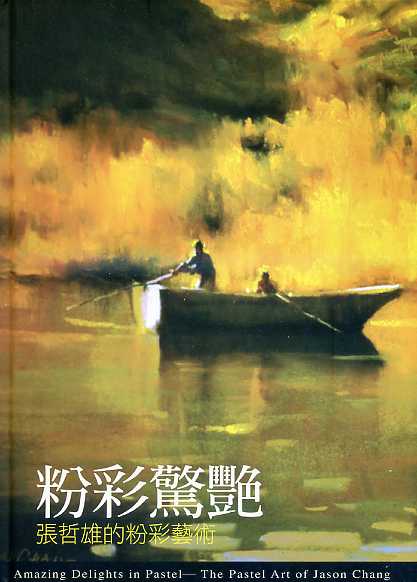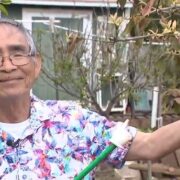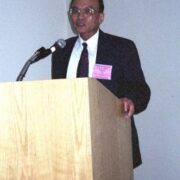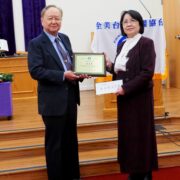粉彩驚艷,其樂無窮
張哲雄 著

序言 PREFACE
赴美定居前,我在台灣曾從事油畫創作二十餘年,也嘗試以粉彩色料來作畫,與一般台灣的畫家一樣,對於粉彩畫的技法都是自行摸索,未有專業的師資傳授正確的技法和畫材的選擇,因此在台灣 畫壇一直看不到有份量的粉彩作品,偶爾有幾位畫家展出他們的粉彩畫,但觀其作品,僅似淡彩的素描,未能發揮出粉彩優異的特質及完整的繪畫性。總之,粉彩藝術在台灣一直未被重視,甚至顯少為人知。
一九八二年我在親友的祝福聲中,來到了世界藝術之都的紐約定居,我一方面繼續嘗試以新觀念來創作油畫,另一方面則進入美術研究所攻讀碩士學位,在研究所進修時,每學期都交出十多幅的繪畫作品,所使用的畫材是粉彩多於油彩,當指導教授看到我的作品時,立即有了興奮的表情,並公開稱讚我的粉彩畫,他認為使用粉彩來作畫,是最明智的選擇。他還強調,當油畫與粉彩畫擺在一起時,粉彩鮮豔瑰麗的色澤和它柔美醒目的光芒,立即超越過油畫,使得油畫顯得黯淡缺乏說服力。經指導教授的鼓勵,我開始以粉彩畫參加美國一些藝術組織的聯展。第一次參加公募作品的競賽便僥倖獲得第三名,在校內的師生聯展中,也多次選用我的作品作宣傳的海報和廣告,更意外的收穫是學校邀請我畢業後留校任教。
經教授的介紹,我終於有機會前往曼哈頓著名的國家藝術倶樂部(National Arts Club),觀賞到美國粉彩畫協會(Pastel Society of America) —年一度公開競賽入選作品的盛大聯展。我曾驚訝地發現粉彩色料竟然能表現這麼多樣性的樣貌,有些作品厚重的質感類似油畫,有些作品飄逸的揮灑如同溼染的水彩畫,另有一些寫實的作品,更是栩栩如生自然生動,其瑰麗的色澤與朦朧、柔和的美感,則更勝於油畫。經歷過高水準的國際性大展後,我便決心投身粉彩的研究,並拜粉彩畫大師理查•皮旺克(Richard Pionk)為師,學習靜物及人物寫生。想不到幾年後,我卻以粉彩的作品打進美國重要的藝術組織,如美國粉彩畫協會(Pastel Society of America)、美國藝術家聯合會(Allied Artists of America)、美國專業藝術家聯盟(America Artists Professional League)、沙瑪冠蒂美術倶樂部(The Salmagundi Club)、奧杜邦藝術家(Audubon Artists INC)等,由於我多次榮獲大獎,而被吸收成為會員、理事和評審委員。一九九八年起應美國粉彩畫協會的邀聘,在國家美術倶樂部的粉彩研究所(School for Pastel Only,PSA/NAC)任教,我以一個移民來美的亞裔畫家,有機會在此地位崇高的藝術組織教授西洋繪畫,讓我深感榮幸。
粉彩畫起源於義大利,如今卻盛行於美國。有跡可尋的是十六世紀的勒尼(Reni)、瑟略(Theile) 皆有作品問世。近代的知名畫家也都畫過粉彩畫,如畢卡索(Picaso)、米羅(Miro)、康丁斯基 (Kandinsky)均有傳世的粉彩作品。二十世紀初,美國著名女畫家Mary Cassatt,她的人物畫及風景 畫都能掌握粉彩的特性,展露粉彩的魅力。粉彩色料採自天然的原色,作畫時不需溶劑,以色條直接塗繪於紙上,毫無褪色或龜裂之虞,不同廠牌的顏色也可混合使用,不像油畫常會產生互相排斥而剝落。美國粉彩畫協會成立於一九七二年,由女畫家基芙尼(Giffuni)發起,聯合幾位酷愛粉彩的知名畫家,創設了全球第一個粉彩畫組織,如今已是第三十五屆,目前是全美各種美術競賽中獲得獎項最 多(五十六項獎金)的藝術團體,其一年一度的公開大賽,總吸引來自世界各地的參賽者寄來的幻 燈片,為數多達兩千件以上,只入選其中的一百五十件左右,每年九月間固定在國家藝術倶樂部的正廳畫廊公開展出,一些西洋畫家都以參加該項競賽為努力的目標,一九九八年至二〇〇三年間我有幸參與公開賽的評審工作。
當我在展覽會場或是舉行講座時,經常會有來賓問及有關粉彩畫的一些問題,如粉彩色條的製作、紙張的選擇、保存的方法、作畫的技巧以及市場的價值等。在這裡,我把有關粉彩的基本常識也就是一般民眾對粉彩有興趣而又想深入探討的一些問題簡單扼要的敘述出來,希望有助於大家的瞭 解,進而參與粉彩的研究與創作。
粉彩色條的製作
粉彩色條是以少量的膠或樹脂與礦物質的色粉混合膠凝結而成的一種棒條畫材。例如,一顆千年的紅石頭,拿來碾成粉末,作為紅色的粉彩顏料,用它畫成的粉彩畫,再經一千年,肯定鮮豔如昔,永不褪色。基本上,粉彩的色條有三種不同的特性,即硬性、半硬性、軟性,其軟硬的區別是以膠和樹脂用量的多少來決定。軟性的粉彩因膠量少不易成型,彩度卻很高,算是最高級,美術材料店 裡常見的有Sennelier、Schmicke等廠牌。半硬性的價格比軟性為低,如Rembrandt便是一般畫家常用的色料,硬性的粉彩,在市面上尤其普遍,初學者都選用Nu-Pastel、Yarka、Come及Ho丨bein等廠牌。粉彩的色條與寫在黑板上的粉筆(Chalk)是完全不同的材料,後者是以染料加上石灰做成的,不可能用來作畫。
粉彩畫用紙
專用的畫紙都已染好底色,有數十種色調可供選擇,而且畫紙的表面處理,也有粗細之分,粗糙的畫紙適合用來畫色彩豐富、細腻的作品,而較平滑的紙張則適合於簡練的速寫,選對了畫紙的底色和紋理,作畫時的確可達到事半功倍的效果,市面上可供選擇的粉彩用紙種類繁多,有不少物美價廉的畫紙,如Canson便是不錯的品牌。有些粉彩畫家喜歡用粗厚的水彩紙,先以水彩顏料塗上自己喜歡的底色,等乾了以後再畫粉彩。另有一種特製的畫紙,是以細沙粘在紙板上,可以增加色粉的附著力,如法國Sennelier公司生產的La Carte粉彩用紙,便是廣受喜愛的產品之一。另一種粘有細沙的畫布,則可以捲成圓筒,攜帶十分方便。
粉彩技法
粉彩畫與油畫、水彩畫的共同性便是必須具備良好的素描基礎以及懂得透視、構圖、色彩運用等基本常識。作畫的第一步便是打輪廓,一般畫家都使用木炭條來畫輪廓,也可直接使用粉彩色條來起稿,有了輪廓之後便可用深色來畫陰影部分,再以淺色描繪亮處,因畫紙本身已是中間色調,加上明暗處理之後,畫面即呈現簡略的立體美感。再以準確、奔放的筆觸予以重複上色和修飾。硬性的粉彩適合打底色,軟性的粉彩則適用於近乎完成時,用它來強調畫面上亮處的光束和鮮豔的視覺焦點。古時候的粉彩畫,適用的顏色較少,主要的作品是描繪宮廷裡的貴婦、少女的肖像,為了呈現人體膚色細腻柔美的質感,當時的畫家都使用擦揉的方式,來調出不同明暗的層次。十九世紀以 後,粉彩畫家不再以人物為主要的題材,印象派的畫家更善用鮮豔的色彩,一整套粉彩的顏色便增加到五、六百色,畫起來比油畫更能達到預期的效果。而技法上也有了突破,由細腻的擦揉到厚重、粗獷的筆觸;甚至於將色條橫置,刮出大片的色塊來,多樣性的技法,使得粉彩得以充分的發揮,表現出不同的風格。粉彩也需要修改與調整,一般多採用軟性的橡皮擦或以刀片輕刮需要修正的部分,也可以用硬毛的筆刷除去不要的顏色,再重新上色。粉彩不可畫得太厚,因為多餘的色粉 容易脫落。
粉彩的保存方法
一般都認為粉彩畫一碰便會掉色,是最不容易保存的藝術品,的確,如用手去摸畫面必定會沾些色粉,不過那也只是多餘的色粉才會被沾掉,畫面則還是完整無缺。完成一幅粉彩畫後,只要立即配框、裝上玻璃便可一勞永逸,沒有保存上的問題。有些畫家喜歡噴上固定液,使浮在畫面上的色粉不再震落,這也是可行的方法,我個人則喜歡噴上薄薄的一層固定液,然後在主題的部分重新塗上鮮豔的色彩,以凸顯視覺焦點。
粉彩的藝術價值
粉彩在美國,三十幾年前還不太盛行,當時以粉彩作品參加畫展,常被列在水彩畫類或與素描合併,經由美國粉彩畫協會的大力提倡之下,如今任何綜合性的繪畫競賽,皆設有獨立的粉彩畫類。 全美各州的粉彩組織、協會應運而生,其活動的頻繁已勝過任何其他的畫種。美國學校的一些美術系裡,也有專業的教授指導粉彩的技法。富比士拍賣會中,迪嘉斯的粉彩畫曾以五百多萬美元成交,卡薩特的粉彩作品,也曾在拍賣會中賣得了三百多萬美元,而當代粉彩畫家的一幅粉彩畫售價數萬美元也是常有的事。在此特別一提的就是在部分混合畫種的競賽中,小幅的粉彩畫經常擊敗大幅的油畫或水彩畫而獲得首獎。收藏家及美術館已了解粉彩畫的藝術價值,也有多處展場收藏了我的畫作,紐約金鷹學院前任院長李清澤博士,也積極參與粉彩藝術的推廣,他於二〇〇〇年起聘我在該校教授粉彩藝術課程,並和夫人林榮峰女士同時在我的班上學畫,兩人皆好學不倦,成績斐然,二〇〇五年及二〇〇六年李博士與我共同策劃、舉辦了兩屆《國際粉彩畫公開賽》,此計畫並 獲得紐約台灣會館理事長賴宏典醫師及該館發起人陳隆豐律師的協助,當年五月隆重展出所有入圍、得獎的佳作六十餘幅,此一盛舉深得美、歐藝術界的稱讚與認同,使得會館一時成為國際藝術交流的熱門場所,各族裔歡聚一堂,盛況空前,令人難忘。
教育部駐紐約經文處主任陳東榮博士對旅美的台灣粉彩畫家,也給予相當多的肯定和勉勵。他駐紐約期間,每年必出席北美粉彩畫家協會的聯展開幕盛會,並促成北美粉彩畫家協會與國立臺灣藝術教育館的合作,聯合舉辦《國際粉彩畫家邀請展》,其夫人劉碧芬教授對粉彩藝術也頗有心得,並 提供大作參加此一重要的國際聯展。來自臺灣的紐約畫家中,近年來也經常參與粉彩的創作,與我一起研究、切磋的就有近百人。他們常有佳作參加聯展、競賽,且常獲頒獎狀表揚,為畫壇眾所矚目。粉彩畫色料是一種物美價廉的畫材且具有簡便、立即見效的作畫特性。希望藉此書引起國內及 海外同好對粉彩畫的了解,進而激發大家參與粉彩藝術的創作與研究。
旅居美國近三十年,從未想過在台灣出版一本有關我個人的作品專輯。二〇〇七年五月間,我返台參加國立臺灣藝術教育館所主辦之《國際粉彩畫家邀請展》,承蒙吳館長祖勝的邀約出版畫冊,我當時心存感激,也感到惶恐,不知以何種形式或內容來著手準備所需的資料。返美後幸與藝教館研究推廣組王鳳翎小姐取得聯繫,經由她的建議,獲悉蒐集資料的方向,且得到歐美畫壇舉足輕重的三位好友的熱情支持,短時間即為我撰寫介紹的文章,他們是美國粉彩畫協會會長蕾•史密斯 (Rae Smith)、法國粉彩畫協會會長秀雅卡布(Sylvie Cabal)、奧杜邦藝術家協會粉彩畫部主任蘿達 雅諾(Rhoda Yanow )。
在此也要感謝兩位與我一起共事,同樣來自臺灣的優秀女畫家陳麗美(北美粉彩畫家協會副會 長)、蔡惠珠(北美粉彩畫家協會財務長),兩人為我整理文字資料、製作圖檔,有了她們鼎力相助才能在短時間內如期出版這本對我個人而言相當重要的作品專輯。同時我也要感謝九十九度藝術中心的董事長張靜文女士、總監許芳智先生,他們獨具慧眼,鍾愛粉彩藝術作品,為我及張美華(北 美粉彩畫家協會之會員資格審查主席)長期舉辦個展,在台灣他們堪稱為是推廣粉彩藝術的先驅。
會長 張哲雄
北美粉彩畫協會
Joy of Painting with Pastel
Before migrating to the US, I had done oil paintings for over 20 years and sometimes I also tried painting with pastels in Taiwan. Like many other Taiwanese artists, I had explored painting with pastels on my own. Under the circumstances in which no professional pastelists were available in Taiwan, excellent pastel paintings could hardly be found in the art field due to lack of learning the proper techniques and choices of painting materials. Although some artists sometimes exhibited their pastel artwork, I only found light sketches with neither emphasis on the unique essence of pastel nor a complete picture when looking at them. In short, attention was rarely paid to this field and not many people knew much about the pastel medium.
In 1982,with the blessing of my relatives and friends, I came and settled down in New York, city of the art world. I continued my oil paintings with new ideas. On the other hand, I also enrolled at a postgraduate college to earn a Master’s degree in Fine Art. In those postgraduate days, I was required to submit over 10 paintings every semester. I used more pastels as my painting materials than oil at that time. My professor excitingly looked at my work and even gave me compliments in public on my pastel paintings. He had expressed that using pastel was the wisest choice. He also emphasized that the vivid colors and the silky soft textures of pastel were much more outstanding than those of oil, so that oil paintings appeared inferior and lacked persuasiveness in comparison. With his encouragement, I started submitting my pastel paintings to art organizations and taking part in their joint exhibitions being held in America. At my first competition, I was very lucky to win the third prize. In some joint exhibitions for students and teachers that took place in my postgraduate institution’s campus, my paintings were often chosen to be posters or for advertising promotion. The most fortunate thing was that the university asked me to work as a lecturer after graduation.
Through professors’ recommendations, I finally had an opportunity to attend Manhattan’s well-known National Arts Club’s exhibitions. I went to see Pastel Society of America’s annual exhibition. I was in awe and came to realization that pastel can be represented so many different varieties. In some artwork pieces, thick and heavy strokes of pastel were applied and it almost resembles oil painting. Some appear like water color paintings because of their free and flowing outlook. There are some realistic pieces that have natural, vivid and moving representation. The beautiful colors and velvety aesthetics actually surpass oil paintings. Having experience such a superb international exhibition, I decided to devote myself to pastel. So I asked Richard Pionk, the master of pastel, to be my instructor to teach me on subjects: still life and portraiture. Unexpectedly, several years later, as a pastel artist, I joined America’s significant art organizations, such as the Pastel Society of America, Allied Artists of America, America Artists Professional League, The Salmagundi Club, and Audubon Artists INC. Having won so many important awards,I was also invited to become their fellow member, board member, competition juror and etc. In 1998, the Pastel Society of America invited me to teach in School for Pastel Only, PSA/NAC. I have been one of their lecturers since then. As an Asian artist migrating to America, I am honored to be teaching Western art in such a highly respected art organization.
Pastel painting started in Italy and has now become popular in America. In the sixteenth century, Reni’s and Theile’s paintings were made with pastels. In modern times, famous artists such as Picasso, Miro, and Kandinsky also used pastels in their work. In the early twentieth century, the famous female American artist Mary Cassatt’s Portraiture and Landscape paintings represent her capacity and understanding of the unique nature and charms of pastels. Pastels are made of elements taken from the original colors of nature. So when paintings with pastels one doesn’t need any solvent. They can be directly applied to the surface of paper. Colors will not fade or crack. Pastel colors of different brands can be mixed which is different from oil paintings whose colors often reject (chemical reaction from the mixture of different oil colors) each other cause the surface to peel off.
Being established in 1972, Pastel Society of America, the world’s first pastel art organization, was founded by a female artist, Flora Giffuni, who linked up several famous artists who also loved to work with pastels. There has been a history of 35 years. So far, it is an art institution which has won the most awards (56 awards altogether) in American art competitions. Its annual open jury exhibition always attracts many artists who would submit their slides from all over the world. The number of entries often reaches over 2,000. Having to choose from so many entries, only around 150 can be selected for exhibition. In September of every year, the exhibition is opened to the public in National Arts Club. Many Western artists look forward to participating in this annual elite competition to gauge their own success in the Pastel art field. During 1998 and 2003, I was selected and worked with the competition juror team for their annual open exhibition.
When I was available during exhibitions or conducting workshops, some guests and audiences have often asked me questions such as making of color pastel stick, choice of paper, methods of preservation, techniques of painting, and the market values. Here, I would like to use a simple and direct way to explain basic knowledge about pastels which the general public might be interested and would like to further explore. Hopefully, it can help people to have better understanding and build up enthusiasm for them to participate in pastel activities.
Making of Color Pastel Sticks
Color pastel bars are a kind of bar-shaped painting materials made of congealing of small amount of gum or resin and mixture glue of mineral color powder. For example, one thousand-year-old red stone is processed and broken down into powder. Then red pastels are made with the powder from its original color. Any artwork painted with this can endure one thousand years. The colors can remain the same and never fade. Basically, color pastel bars have three different kinds-hard, semi-hard and soft. The various types depend on the amount of glues and resins that were mixed in. Soft pastels are the hardest to be molded into shapes because of the minimum amount of glue that’s mixed in, but they have the highest color vibrancy. So they are considered the best of pastel materials. In art shops, one can often see brands of Sennelier and Schmicke for this kind. Semi-hard pastels is the next level, they cost less than soft ones. Brand of Rembrandt is the most common for artists to use. Hard pastels are especially popular in the market. Beginners can choose brands of Nu-Pastel, Yarka,Conte, Holbein and etc. In the aspect of materials, color pastel sticks are different from chalk used on blackboards. The latter are made of dyestuffs and limes and
cannot be used to paint.
Use of Paper Applied to Pastel Painting
The special type of paper used for pastel most of them have been dyed into different colors. There are tens of colors to choose from. The surfaces of paper can be either rough or refined. Smooth paper is suitable for rich colors and delicate work. Rough paper is better for brief sketches. If an artist chooses the right colors and texture, maximum results can be achieved with minimum effort. In the market today, there are numerous kinds of papers for pastels. Many of them are good-quality and reasonable in price. For example, Cannon is a pretty good brand. Some pastel artists like to use rough and thick water color paper. Firstly, they apply their favorite water colors to the paper. After it’s dry, they can then use pastel on top of it. Another special type of paper is paper boards glued with refined sand which can help increase the brightness of pastel colors. For example, La Carte paper for pastels, produced by Sennelier, is one of the most popular papers. In addition, there are canvases glued with refined sand which can be rolled into a cylinder shape so that it’s handy to carry.
Technique of Pastel Paintings
The common features for artists in pastels, oil, and water color paintings are to possess good foundation of sketching and understand basic knowledge of perspective, composition and use of colors. The first step is to outline. Generally, artists like to use charcoal to make outlines. However, they can start with pastel sticks directly as well. After outlining, they can use darker colors to make shadows and then lighter colors to depict brighter areas. The paper itself already has medium color tone and with the added contrast between light and shadow, a three-dimensional effect is apparently achieved. Then, the next step is to use precise applications and repeated coloring to polish off the final touch. Hard pastels are suitable for coloring the bottom layer whereas soft pastels are, while one is approaching to finish a painting, employed to emphasize the color vibrancy and its visual focus. In the old times, only few suitable colors of pastels could be used. So they were mainly applied to the portraits of royal women and girls in history. To represent human bodies, delicate skins and fine quality, artists at that time used a rubbing technique to create different bright and dark colors. Since the nineteenth century onwards, pastel artists no longer regarded portraiture as the main subject. The Impressionists were experts at using bright colors. A set of color pastels could be increased between 500 to 600 colors. When compared with oil paintings, a wonderful effect from pastels could be easily predicted and achieved. In techniques, there was a significant breakthrough. It ranges from delicate rubbing of pastel to thick, heavy and rough strokes. And artists can even use a whole color stick in a horizontal rather than vertical way to make large color patches. Varieties of techniques using pastels can bring into full play and demonstrate different styles. Correction and adjustment are needed in pastel paintings. Generally, soft rubber erasers, razor blade or credit card are applied to parts of correction as well as a paint brush with hard hair brushes through to get rid of unwanted colors. Then,the color is renewed. There is no need to apply too much pastel because the extra layer of color can easily fall off.
Way of Preserving Pastels
It’s commonly thought that pastel paintings are not easily preserved because its colors may fade away if they are touched. If one touches paintings with hands, surely some color powder will fall. However, only the excess powder will be taken off, images will still retain their completeness. As long as mounting on a frame covered with glass as soon as a painting is finished, there’s no problem to preserve the work. Some artists prefer to spray with fixative to make color powder of pastels paintings stay on. It’s a wonderful idea. I personally like to spray a thin layer of fixative and re-paint the colors on the subject in order to highlight visual focus.
Art Value of Pastel Paintings
In the US, pastel paintings were not popular for more than thirty years ago. At that time, if being submitted for exhibitions, pastel paintings were often categorized into categories of water color paintings or drawings. Under the influential promotion of Pastel Society of America, in any comprehensive artist competitions, an independent category of pastel paintings was established. In every state of America, pastel organizations and associations have been rapidly established since. Their activities took place more frequently than any other art categories. In America, professional pastel masters are employed to teach in universities and institutions. In Sotheby’s, one of Dega’s pastel paintings was sold for over five million US dollars. Cassatt’s pastel artwork was once sold for over three million US dollars in auction. The price for many contemporary artists’ pastel artwork often soars to over one million US dollars. Here, it is worthy of mentioning that in competitions of mixed art categories, small pastel paintings can surpass large oil paintings and win the first prize. Collectors and art galleries have gradually understood the value of pastel art. Many galleries have also collected my work. Dr. Chin T. Lee,former Director-General of Golden Eagle College in New York, has also fervently promoted pastel paintings. From 2000 onwards, I have been employed to teach pastel art in this institution. Dr. Lee and his wife Emily Lee were both my students. Both of them worked diligently and produced beautiful artwork. In 2005 and 2006, Dr. Lee and I planned and organized annual International Public Competition of Pastel Paintings consecutively. This competition got the help from Dr. Lai, Hong-Tien the board chairman of New York Taiwan Center, and Chen, Long-Fong the lawyer and the initiator of this center. In May during both years, there were over 60 pastel paintings selected for prizes from the exhibitions. The grand events have won compliments and recognitions of American and European art circles as well. The New York Taiwan Center suddenly became a venue for an international art exchange and gathering for Taiwanese immigrants. The events were unprecedented in grandeur and unforgettably remarkable.
Dr. Chen, Tung-Jung who works as the Director-General of Taipei Economic and Cultural Office in New York had offered great support and encouragement to Taiwanese pastel artists living in America. During the period of his stay in New York, he always joined the grand opening of the exhibition organized by Northern America Pastel Artists Association every year. In addition, he also helped to network with National Taiwan Arts Education Center to organize International Exhibition for Invited Pastel Artists. His wife, Professor Liu, Pi-Fen was also good at pastel paintings and her work has been also exhibited in the exhibition. In recent years, nearly one hundred artists coming from Taiwan and living in New York have worked with pastels and also studied with me. Having submitted their excellent work for competitions and exhibitions, they have often been rewarded from their achievements with citations and lots of compliments in the pastel circle. Pastels are excellent painting materials that are superb, inexpensive, handy, and effective. I hope this book can attract art lovers from home and abroad to understand pastel paintings and further inspire the public to take part in creation and studies of pastel art.
I,ve immigrated to New York for nearly 30 years. I,ve never thought about having a biography introducing my own artwork. During May 2007, I went back to Taiwan to participate in the International Pastel Invitational Exhibition which was sponsored by National Taiwan Arts Education Center. It was an honor to be invited by Director General Mr. Wu, Tsu-Sheng. He requested that I provide my artwork, resume, biography and etc. with the purpose of publishing a book about me. I was very grateful and anxious at the same time. I didn’t know where to start to come up with the content and style that was requested of me. Fortunately, I got in touch with Marketing Specialist Ms. Wang, Feng-Ling from National Taiwan Arts Education Center, and she informed and steered me to the right direction. Also, I received fervent support from three American/European brilliant artist friends. In a short time, they all wrote prefaces for my book. The dear friends are Mr. Rae Smith, Director of Pastel Category of Pastel Society of America, Ms. Sylvie Cabal, President of Art du Pastel en France and Ms. Rhoda Yanow, Director of Audubon Pastel Artists.
Additionally, I would like to take this opportunity to express my gratitude toward two very special friends who also came from Taiwan and co-worked with me on this project. They are: Ms. Young, Lee-Mei,Vice President of North America Pastel Artists Association and Ms. Hu, Hui-Chu Treasury of North America Pastel Artists Association. They took care of majority of the word processing, creating image files and etc. for me. Without their assistance, I would not be able to fulfill all the tasks that are involved in order to meet the deadline in such a short amount of time. This is a significant moment in my life. Furthermore, I would like to thank Ms. Chang, President of Ninety Nine Degree Art Center and their General Manager Mr. Hsu. It is through their zeal and passsion for Pastel that brought me and Ms. Jenny Lin, Membership Chair of North America Pastel Artists Association to have long term exhibitions in their gallery. Primarily, Ninety Nine Degree Art Center is considered one of the original art galleries to promote Pastel.
Jason Chang
President
North America Pastel Artists Association






